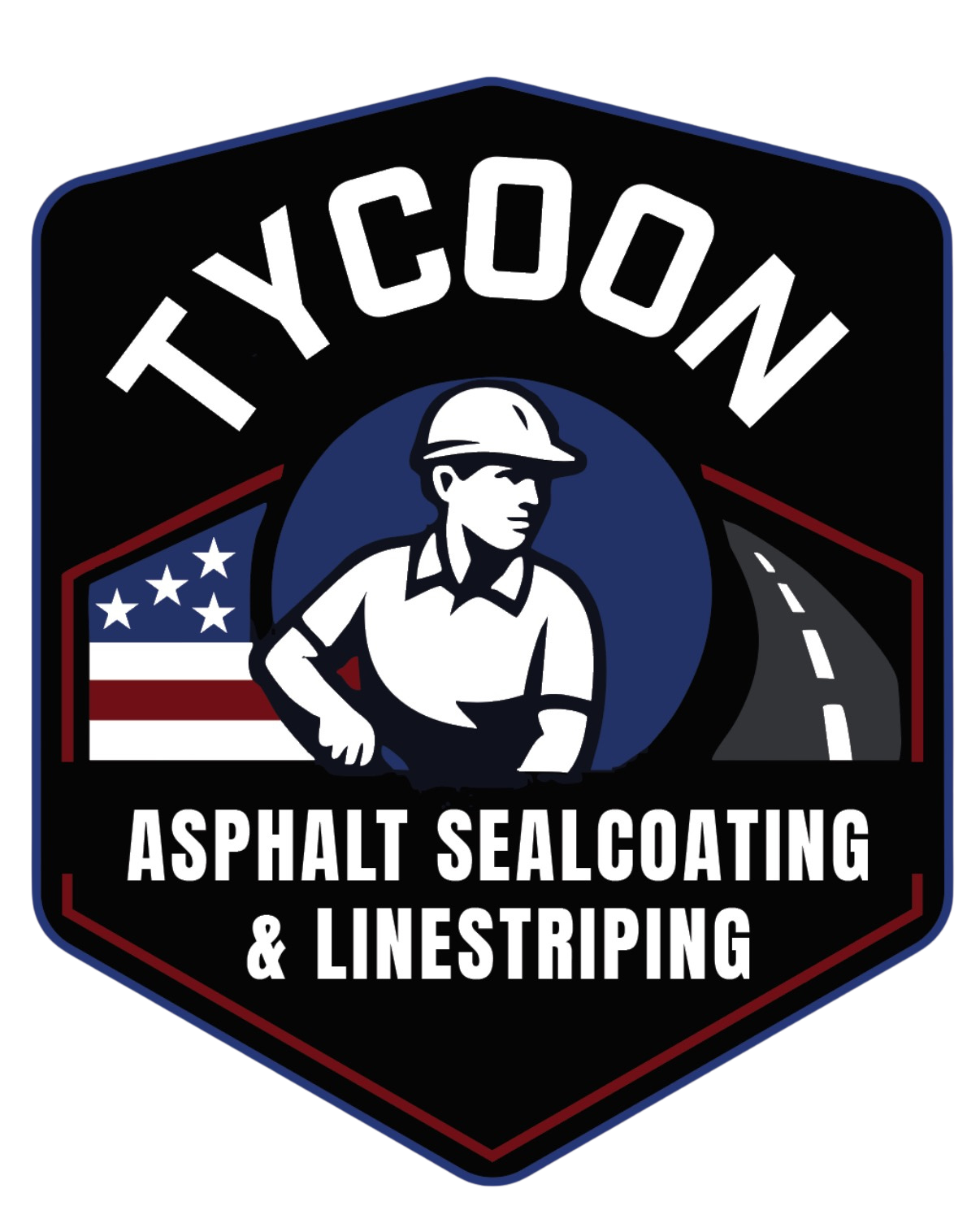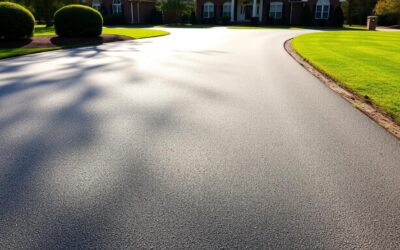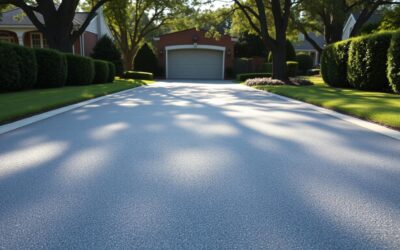We set the stage by explaining how asphalt layer choices depend on soil behavior, drainage, and intended use. Our goal is to give homeowners and property managers a clear, step-by-step view of what to expect from evaluation to final checks.
First, we assess existing pavement and soil, then design a strong base with proper stone and drainage to protect the surface. We explain why a firm base and water control often matter more than simply adding inches of material, especially across varied regions.
We cover seasonal red soils, moisture swings, and common warning signs like alligator cracking so you can spot early issues. Finally, we preview how good compaction, smooth transitions to the road or parking lot, and planned maintenance save time and repairs over the life of the property.
How we evaluate North Carolina soils before setting asphalt thickness
We begin on foot, scanning the property to read visible signs in the ground that influence our plan. A short walk tells us a lot: standing water, soft spots, rutting, or areas that feel spongy underfoot. These clues shape the tests we run and the repairs we recommend before paving.
Red clay realities: plasticity, moisture, and movement
Red clay and red clay soil can be highly plastic and sensitive to moisture. That leads to seasonal movement and changes in bearing capacity. We note where clay dominates so we can plan stabilization and protect the pavement long term.
Subgrade testing on your property: simple field checks
We use quick field checks to assess condition and variability. Probe rod penetration, shovel tests, and a feel test for stickiness tell us where the subgrade is weak. A proof-roll with a loaded truck helps reveal pumping or deflection in problem areas.
When soil stabilization makes sense
We recommend stabilization when clay soil shows high plasticity, poor bearing, or won’t dry in time. Options include lime for plastic clays, cement for fast strength, and geogrid for reinforcement. Targeting only weak areas keeps costs reasonable across north carolina lots while reducing future cracking and callbacks.
Designing a stable stone base to prevent base failure
A well-graded stone base creates even support between the subgrade and the pavement, so loads spread uniformly and weak spots do not lead to base failure. We focus on gradation, lift staging, and moisture control to build a dense, long-lasting platform for the surface layer.
Recommended stone gradations and layer depths across north
We typically use ABC or crusher-run for the main lift and place a finer choke layer on top for a smooth finish. For walkways we choose thinner base depths, for typical residential areas we use moderate depth, and for heavier use we increase the base to handle moving vans and deliveries.
Compaction targets and proof-rolling to spot soft areas
We place stone in lifts and compact each layer to avoid bridging over soft pockets and to reduce air voids. After compaction we proof-roll with a loaded truck or roller to find deflection or pumping and correct those spots before paving.
Where red clay pockets appear, we undercut or stabilize with lime, geogrid, or added stone to stop migration into the subgrade. Careful moisture management — drying, adding fines, or pausing work — helps us meet density goals so a tight base supports thinner asphalt more effectively.
Drainage first: stopping water before it causes cracks and failures
Before we pave, we design how water will move across the lot to protect the base and pavement below.
Surface slopes and transitions
We set positive surface slopes away from buildings and toward safe outlets. Smooth tie-ins to the street or parking lot prevent low spots that trap water and lead to cracks and freeze damage.
Underdrain and edge details
On sites with clay or clay soil, we add underdrain along edges or at upslope areas to relieve pore pressure. Thickened edges, shoulder stone, or concrete ribbons protect margins from unraveling.
Managing downspouts, swales, and flow
We redirect downspouts into swales or inlet boxes so roof runoff never soaks the subgrade. Where fall is limited, trench drains and controlled outlets stop standing water that causes pumping and soft areas.
During construction we check grades with straightedges and run water tests to fix birdbaths before paving. After storms, monitor low areas so you can spot the cause of moisture movement early and call us to correct poor drainage.
Asphalt layer guidance: base and surface course thicknesses
This section gives clear guidance on selecting lifts and mixes to keep pavement performing year after year.
We split roles between the base and the surface layer. The base adds structural strength. The surface adds smoothness, skid resistance, and helps shed water.
Driveway vs. light-duty parking: choosing lifts and mix types
For a standard residential driveway we typically place two lifts. For light-duty parking or occasional delivery trucks we increase lift compactness or strengthen the base instead of relying on a single thick lift.
We select mixes suited to north carolina weather and red clay tendencies. Stone size and binder content help with compaction and long-term performance.
Layer bonding and joint placement to minimize future cracking
We stagger joints and keep seams out of wheel paths when possible. Proper tack coats between lifts ensure layer bonding and reduce reflective cracks.
We verify lift depth with spot checks during paving, and focus on edge compaction near transitions to the road or parking lot to prevent edge failure and raveling.
asphalt thickness driveway north carolina: our step-by-step how-to
Our step-by-step plan walks you through site checks, base-building, layered paving, and final checks so the job lasts.
Assess soil condition and moisture
We start with a quick site review to note soil type, recent rain, and current moisture. This tells us if we must dry, stabilize, or reschedule work.
Set stone base thickness and compact
We set base depth by use and support conditions. Stone base is placed in lifts and compacted to spec, then proof-rolled to find soft spots early.
Install asphalt lifts to target thickness
We place lifts at the right temperature, apply tack between layers, and take periodic checks to confirm target measures are met. Proper compaction between lifts helps the pavement last.
Verify final grade, drainage, and edges
Before we leave, we confirm slopes with string lines and straightedges so drainage moves water to outlets, not under the surface.
We compact edges, tidy tie-ins at the street and garage, and walk the site with you to explain maintenance, warranty, and practical solutions. Our team documents depths, methods, and features for your records.
Spotting problems early: alligator cracking, movement, and other signs
Catching small pavement problems early keeps repairs simple and cuts long‑term costs. We teach simple checks you can do after a storm or during routine walks around the lot.
What alligator cracking tells us about the subgrade
Alligator cracking is a grid of interconnected cracks that looks like reptile skin. When we see alligator cracking, it is usually a sign the subgrade or base support is failing, not just a thin surface issue.
Distinguishing surface issues from base failure
Isolated linear cracks or minor raveling are often surface problems you can seal. Widespread, closely spaced cracks, rutting, depressions, or moisture pumping point to deeper failure and need full‑depth patching.
Clay soils and wet cycles make movement worse; watch problem areas after rain. Take photos, note locations and any deflection, and share measurements when you contact us. Our triage separates immediate safety fixes, short‑term mitigation, and long‑term structural repair so you save money and keep the pavement usable in north carolina.
Costs, maintenance, and repair options over the years
Predictable costs and timely upkeep keep your pavement reliable year after year. We outline the main cost drivers so you can budget: base preparation, drainage features, site access, and choices made for the property.
Preventive maintenance timing in North Carolina’s climate
We recommend a simple timeline: initial curing checks, first sealcoat roughly 12–18 months after installation, and crack sealing every 2–4 years depending on use. Summer heat and seasonal rain in north carolina shorten ideal time windows, so we plan services around dry periods.
Timely crack sealing blocks water from reaching the subgrade. That slows cracking progression and reduces the need for major repairs later. When small cracks appear, seal them quickly to stop bigger problems.
Options range from preventive services—sealcoating and crack fill—to corrective repairs like skin patches or full‑depth patches. Overlays save money where the base is sound. Remove and rebuild when support or drainage is the cause of failure.
Compare contractor proposals carefully: check specs, warranties, and included services. Set aside annual time after heavy rains to inspect for ponding, rutting, or new cracks. Call us early if you see alligator cracking or soft spots so we can propose targeted solutions before the issue spreads.
Ready for a longer-lasting driveway? Our team can design the right thickness and drainage solution
Book an on-site review so our team can map drainage, test soil, and tailor a base and layer plan for your property across North Carolina.
.
We explain our services in plain terms: match asphalt layer choices to traffic, select the right stone base, and add underdrain or edge details where poor drainage or red clay needs extra support. We outline soil stabilization options—lime, cement, and geogrid—to limit movement and strengthen the subgrade.
We flag key signs of long life: positive drainage, dense base, bonded lifts, and clean transitions to the street or parking lot. Share your address, site photos, and any prior repairs. We’ll provide a clear, itemized proposal so you can compare contractors and start with no-pressure solutions.




0 Comments